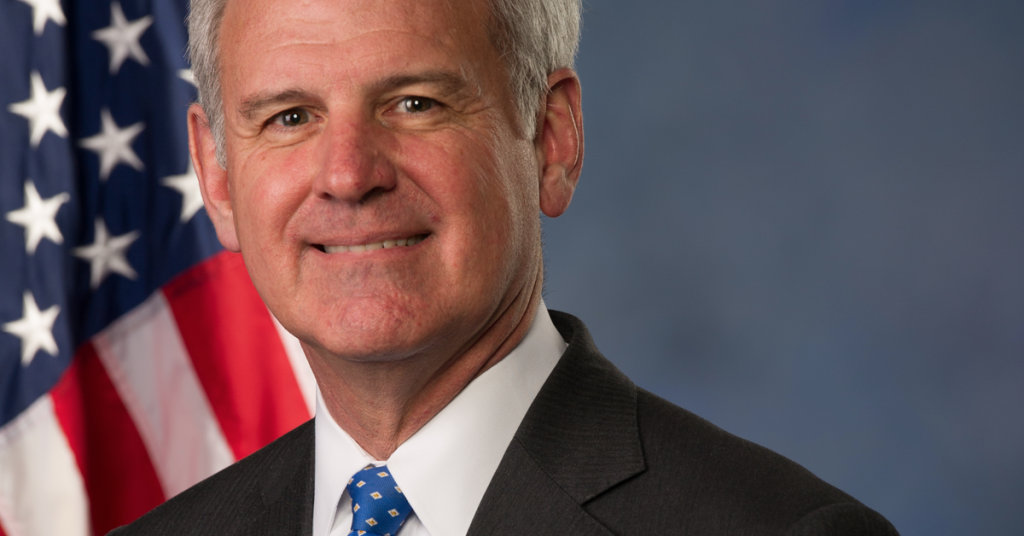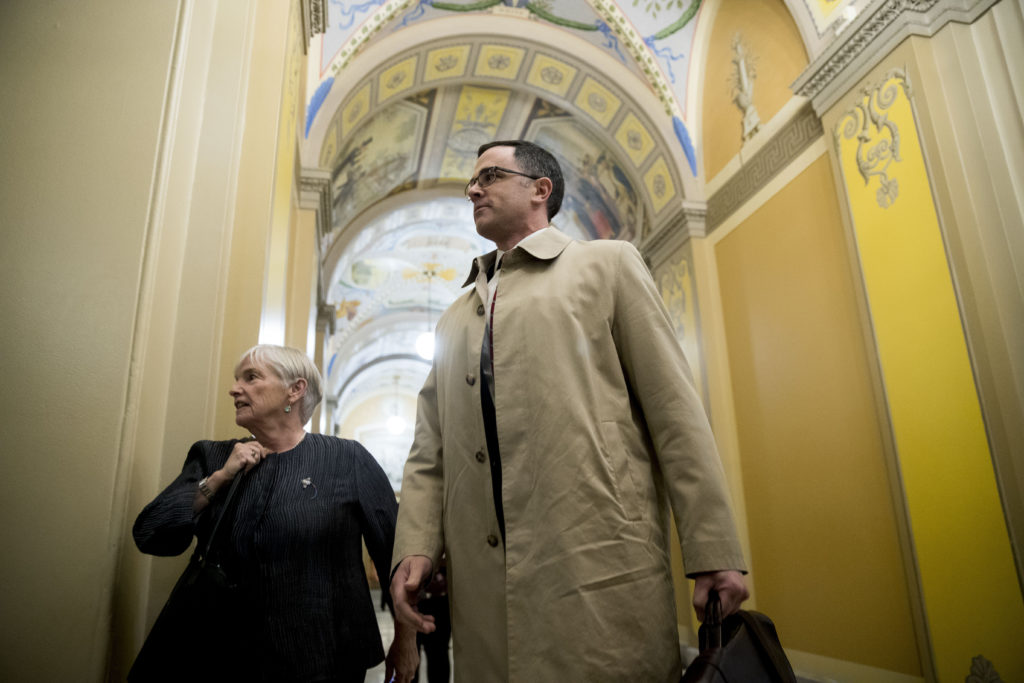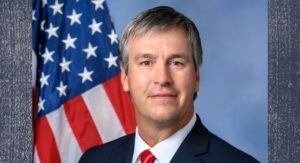Bradley Byrne: Our common defense

Republicans backed an amendment to require the service secretaries responsible for those bases to review the use of those names going forward but did not want to dictate to them what their decision should be.
Donald Trump faces pressure over Russia bounties to kill US troops

Trump won’t say publicly that he is working to get to the bottom of the issue.
GOP lawmakers urge action after Russia-Afghanistan briefing

Members of Congress in both parties called for additional information and consequences for Russia and its president, Vladimir Putin.
Ex-Donald Trump adviser arrives to testify in impeachment inquiry

President Donald Trump’s former top adviser for Russian and European affairs arrived on Capitol Hill Thursday to testify to House impeachment investigators, a day after leaving his job at the White House. Tim Morrison, the first White House political appointee to testify, didn’t respond to reporters’ questions about his testimony, which takes place behind closed doors, but his information might be central to a push to remove the president from office. Morrison, who served on the National Security Council, stepped down from that post Wednesday, and a senior administration official said he “decided to pursue other opportunities.” The official, who was not authorized to discuss Morrison’s job and spoke only on the condition of anonymity, said Morrison has been considering leaving the administration for “some time.” He has been in the spotlight since August when a government whistleblower said multiple U.S. officials had said Trump was “using the power of his office to solicit interference from a foreign country in the 2020 U.S. election.” Morrison will be asked to explain that “sinking feeling” he got when Trump demanded that Ukraine’s president investigate former Vice President Joe Biden and meddling in the 2016 election. Morrison was brought on board by then-national security adviser John Bolton to address arms control matters and later shifted into his current role as a top Russia and Europe adviser. It was there that he stepped into the thick of an in-house squabble about the activities of Trump’s personal attorney Rudy Giuliani, who had been conversing with Ukrainian leaders outside of traditional U.S. diplomatic circles. Known as a “hawk” in national security circles, Morrison is the first political appointee from the White House to testify before impeachment investigators. The probe has been denounced by the Republican president, who has directed his staff not to testify. Regardless of what he says, GOP lawmakers will be hard-pressed to dismiss Morrison, formerly a longtime Republican staffer at the House Armed Services Committee. He’s been bouncing around Washington in Republican positions for two decades, having worked for Rep. Mark Kennedy, Republican-Minnesota, Sen. Jon Kyl, Republican-Arizona, and as a GOP senior staffer on the House Armed Services Committee, including nearly four years when it was chaired by Rep. Mac Thornberry, Republican-Texas. Morrison’s name appeared more than a dozen times in earlier testimony by William Taylor, the acting U.S. ambassador in Ukraine, who told impeachment investigators that Trump was withholding military aid unless the new Ukrainian president, Volodymyr Zelenskiy, went public with a promise to investigate Trump’s political rival Joe Biden and his son Hunter. Taylor’s testimony contradicts Trump’s repeated denials that there was any quid pro quo. Taylor said Morrison recounted a conversation that Gordon Sondland, America’s ambassador to the European Union, had with a top aide to Zelenskiy named Andriy Yermak. Taylor said Morrison told him security assistance would not materialize until Zelenskiy committed to investigate Burisma, a Ukrainian gas company that once employed Biden’s son. A White House meeting for Zelenskiy also was in play. “I was alarmed by what Mr. Morrison told me about the Sondland-Yermak conversation,” Taylor testified. “This was the first time I had heard that the security assistance — not just the White House meeting — was conditioned on the investigations.” Taylor testified that Morrison told him he had a “sinking feeling” after learning about a Sept. 7 conversation Sondland had with Trump. “According to Mr. Morrison, President Trump told Ambassador Sondland that he was not asking for a quid pro quo,” Taylor testified. “But President Trump did insist that President Zelenskiy go to a microphone and say he is opening investigations of Biden and 2016 election interference, and that President Zelenskiy should want to do this himself. Mr. Morrison said that he told Ambassador Bolton and the NSC lawyers of this phone call between President Trump and Ambassador Sondland.” Morrison told people after Bolton was forced out of his job that the national security adviser had tried to stop Giuliani’s diplomatic dealings with Ukraine and that Morrison agreed, according to a U.S. official, who was not authorized to discuss Morrison’s role in the impeachment inquiry and spoke only on condition of anonymity. The official said Morrison told people that with the appointment of Robert O’Brien as Bolton’s successor, his own future work at the NSC was in a “holding pattern.” Bolton had brought Morrison into the NSC in July 2018 as senior director for weapons of mass destruction and biodefence. He’s known as an arms control expert or an arms treaty saboteur, depending on who you ask. Morrison, who earned a bachelor’s degree from the University of Minnesota and a law degree from George Washington University, keeps nuclear strategist Herman Kahn’s seminal volume on thermonuclear warfare on a table in his office. Daryl Kimball, executive director of the Arms Control Association, said Bolton and Morrison are likeminded. Kimball said both have been known for calling up GOP congressional offices warning them against saying anything about arms control that didn’t align with their views. “Just as John Bolton reportedly did, I would be shocked if Morrison did not regard Giuliani’s activities as being out of bounds,” said Kimball, who has been on opposite sides of arms control debates with Morrison for more than a decade. By Deb Riechmann Associated Press Associated Press writers Zeke Miller and Matthew Lee contributed to this report. Republished with the permission of the Associated Press.
After 2 months, Jim Mattis is only Donald Trump pick at Pentagon

Jim Mattis is not lonely in the Pentagon, but two months into his tenure as secretary of defense not a single political appointee has joined him. The retired Marine general, who took office just hours after President Donald Trump was sworn in, has sparred with the White House over choices for high-priority civilian positions that, while rarely visible to the public, are key to developing and implementing defense policy at home and abroad. When the Obama administration closed shop in January, only one of its top-tier Pentagon political appointees stayed in place — Robert Work, the deputy defense secretary. He agreed to remain until his successor is sworn in. So far, no nominee for deputy has been announced, let alone confirmed by the Senate. The administration has announced four nominees for senior Pentagon civilian jobs, and two of those later withdrew. Trump’s nominee to lead the Army, Vincent Viola, withdrew in early February because of financial entanglements, and about three weeks later Philip B. Bilden, the Navy secretary nominee, withdrew for similar reasons. On Tuesday, the White House announced it intends to nominate John J. Sullivan to be the Pentagon’s chief lawyer. In January, Trump announced former congresswoman Heather Wilson of New Mexico as his nominee to be Air Force secretary, but he has not submitted the nomination to the Senate. “The process has definitely slowed,” said Dov Zakheim, who served as the Pentagon budget chief during the George W. Bush administration. He said he would be surprised if Mattis gets any senior appointees confirmed before mid-April. “The delays are already causing much consternation among allies, especially in Europe and Southeast Asia, as their most senior working level day-to-day contacts – the deputy assistant secretaries — may not come onboard until the summer,” Zakheim said in an email exchange. “Lots of mayhem could take place before then.” This is not an issue at the Pentagon alone. While most of Trump’s choices for Cabinet and Cabinet-level posts have won Senate confirmation, 500-plus government-wide sub-Cabinet level positions requiring Senate confirmation remain unfilled. There are few visible signs that the absence of Trump appointments in the Pentagon has affected its management of the counter-Islamic State campaign or military operations in Afghanistan. But the president has ordered a number of major policy reviews that require senior-level Pentagon attention, including counter-IS strategy, nuclear and missile defense plans and a blueprint for building up and improving the combat-readiness of the military. Even Republicans are taking note. Rep. Mac Thornberry, chairman of the House Armed Services Committee, said at a hearing Wednesday that when lawmakers have nuclear policy questions, “we do not have people in place in the new administration to answer some of those questions.” Pentagon insiders say the appointment process, while contentious at times, has not produced significantly more friction than previous transitions in which the White House changed political parties. Democrat Barack Obama had fewer issues at the Pentagon when he took office in January 2009 because he kept in place Bush’s defense chief, Robert Gates, and Obama’s transition team quickly settled on nominees for key senior defense policy jobs. When Bush made Donald H. Rumsfeld his defense chief in January 2001, Rumsfeld did not get his policy chief, Douglas Feith, in place until July. Rumsfeld, however, had an advantage that Mattis does not: some of his predecessor’s senior staff agreed to remain for months. By Rumsfeld’s count, it took the Bush White House 70 days on average to approve a recommended nominee, plus 52 more days for Senate confirmation. A Pentagon spokesman, Navy Capt. Jeff Davis, said Mattis is committed to getting the right people in key jobs. “He and his staff are actively conducting interviews and working collaboratively with the White House to nominate people to the Senate for confirmation,” Davis said. “We are in the final stages of vetting on several of these, and expect they will be announced soon.” Walter Slocombe, who served as policy chief at the Pentagon during Bill Clinton‘s presidency, said the appointments process is unavoidably sluggish because of extensive political and security vetting. “Having said that, it’s a very bad idea that it takes so long,” he said. Career civil servants can fill the void for a time, but their power is limited. “They’ll do enough to keep the engine turning over and be a big help in a crisis, but they’re not able to take the lead on policy formation,” he added. Mattis has said little publicly about the pace of getting a new team installed, but officials familiar with the process say he and the White House have been at loggerheads on some picks. The officials spoke on condition of anonymity to discuss internal deliberations. Mattis may be about to prevail in one important appointment — Anne W. Patterson, a career diplomat and former ambassador to Egypt and Pakistan who recently retired after serving as the State Department’s assistant secretary for near eastern affairs. Officials expect her to be announced soon as Trump’s nominee to serve as undersecretary of defense for policy, a position of broad responsibility for steering policy. Critics, including some Republicans, opposed her selection on grounds that as ambassador in Cairo she was too accommodating to former Egyptian President Mohamed Morsi and the Muslim Brotherhood. Among other key Pentagon offices still without a presidentially appointed leader: intelligence, budget chief, weapons buyer, technology chief and personnel policy. These and other top positions were vacated by Obama appointees at the end of his term or earlier last year; they are now run by holdover officials in what the Pentagon calls a “performing the duties” status, meaning they can do the work unless it involves a duty that by law can be performed only by a Senate-confirmed appointee. Republished with permission of The Associated Press.
Bradley Byrne named vice-chair of Seapower subcommittee

Alabama 1st District U.S. Rep. Bradley Bryne has been named Vice-Chair of the Seapower and Projection Forces Subcommittee of the House Armed Services Committee by Committee Chairman Mac Thornberry. “I am honored to serve alongside Seapower Subcommittee Chairman Rob Wittman as we work to build up our Navy fleet and focus on deterring aggression around the globe,” said Byrne. “Our Sailors, Airmen, and Marines are the finest fighting force on the globe, and they deserve the tools and resources necessary to do their job.” He continued, “Serving as Vice Chair, I will continue to advocate for our nation’s shipbuilders, including the hardworking men and women at the Austal Shipyard in Mobile and other Gulf Coast shipyards.” Bryne has served on the full committee since coming to Congress in 2014. The Seapower and Projection Forces Subcommittee has oversight over Navy, Marine Corps and Air Force programs. Through its authorization for Navy, Marine Corps and Air Force procurement and R&D programs, this subcommittee is committed to reversing the decline in the Air Force’s Global Mobility and Bomber forces, Navy battle force fleet, strengthening the naval air component, and providing the Marine Corps warfighter with essential equipment for combat operations. “The world remains a dangerous place with threats increasing in every theater,” said Thornberry. “Ensuring that our troops are the best-trained, best-equipped, and best-supported is even more critical this year. I am encouraged by the members serving as Vice Chairs for this Congress. They bring diverse talent and experience to our committee and its’ mission.”
Donald Trump targets F-35, but aircraft means jobs in 45 states

President-elect Donald Trump is vowing to corral the “out of control” cost of the F-35 Joint Strike Fighter. But congressional Republicans and Democrats, aware of the tens of thousands of jobs the aircraft generates in 45 states, will be wary of any plans by Trump to cut the program. A Monday morning tweet from Trump targeting the F-35 doesn’t explain exactly how he’ll save billions of dollars in military purchases while also honoring a campaign vow to rebuild the armed forces. Once Trump is in office, he can propose deep cuts to the F-35 or even elect to cancel the program altogether. But Congress, not the president, controls the government’s purse strings and makes the final decisions about the budget. Built by defense giant Lockheed Martin, the nearly $400 billion price tag for the F-35 makes the program the Pentagon’s most expensive weapons acquisition ever. Despite the huge cost, the program has strong bipartisan support in Congress, where lawmakers view the aircraft as essential to national security. After Trump’s tweet, Lockheed Martin’s shares tumbled, wiping out nearly $4 billion of the company’s market value. The F-35 program made up 20 percent of Lockheed’s total 2015 revenue of $46.1 billion. U.S. government orders made up 78 percent of its revenue last year. “Whoever has this airplane will have the most advanced air force in the world. That’s why we’re building the F35. That’s why it’s important to not only the U.S., our partners and our partners like the Israeli Air force to have this airplane,” said Jeff Babione, general manager of the F-35 program, at a base in Israel. Israel and several other U.S. allies are also buying the F-35, expanding the program’s international footprint. Defense Secretary Ash Carter visited Israel on Monday as Tel Aviv received the first two next-generation F-35 fighter jets that will help preserve the country’s military edge in the volatile Mideast. The F-35, which uses stealth technology to avoid being detected by radar, is being built in different configurations to be used by the Air Force, Navy and Marine Corps. The Navy’s version, for example, is designed to take off and land on an aircraft carrier. Current plans call for the United States to buy nearly 2,500 F-35s. Close to $13 billion will be needed annually between 2016 and 2038 to hit that procurement number, according to the Government Accountability Office. While the F-35 had massive budget overruns early on, the cost has stabilized and even dropped a bit following tough negotiations between the Pentagon and Lockheed Martin, according to Todd Harrison, a defense budget expert at the Center for Strategic and International Studies. “Trump is unlikely to squeeze more blood out of this rock,” Harrison said. Lockheed said that it has worked to lower the price of the F-35 by 60 percent and expected the aircraft to cost $85 million each in 2019 and 2020. But the company’s estimate appears to omit the price of the engine and the cost of development. When those elements are added in, the cost per F-35 in current-year dollars is closer to $138 million, according to Harrison. Companies from 45 states are involved in the F-35’s production, with Texas, Georgia, California, Arizona and Florida playing the leading roles in testing and manufacturing the jet fighter. The company is teamed with more than 1,250 domestic suppliers to produce thousands of components ranging from highly sophisticated radar sensors to parts of the aircraft’s fuselage, according to Lockheed Martin. Overall, the F-35 program is responsible for more than 146,000 U.S. jobs, the company said. The Lockheed Martin plant where the F-35 is being built is located in Texas Republican Rep. Kay Granger‘s district. She’s vice chair of the defense appropriations subcommittee. Rep. Mac Thornberry, the Republican chairman of the House Armed Services Committee, represents the district next door to Granger’s. In a statement Monday, Granger hailed the F-35 delivery to Israel, calling the aircraft “what we need to keep our two countries safe in these dangerous times.” Thornberry’s committee has supported buying more F-35s than the Obama administration had asked for in its budget request. The F-35 will replace an aging inventory of U.S. aircraft that many lawmakers believe are becoming increasingly unsafe to fly. Claude Chafin, a committee spokesman, said Thornberry “shares the president-elect’s determination to have the Pentagon get weapons in the hands of our troops faster, while being better stewards of the taxpayer dollar.” The tweet on the F-35 marks the second time in a week Trump has blasted U.S. aircraft spending. Last week, he tweeted that costs to build new presidential planes by Boeing Corp. were “out of control” and ended the tweet with “Cancel order!” Republished with permission of The Associated Press.
With Alabama delegation support, House passes sweeping defense bill compromise

With the support of all but one member of the Alabama delegation, the U.S. House of Representatives passed a compromise $612 billion annual defense authorization bill Thursday. The National Defense Authorization Act (NDAA) for Fiscal Year 2016 conference report, legislation correcting differences between the House and Senate, passed with a vote of 270 to 156. The NDAA authorizes funding for the Department of Defense and among other provisions includes a pay raise for troops, overhauling the military retirement system, which is currently only available to the 17 percent of service members who serve 20 plus years, and reworking the Pentagon’s acquisition system to improve efficiency and avoid cost overruns. The afternoon vote, largely along party lines, saw just 36 Democrats support the legislation, putting the final tally just 20 votes shy of being able to override a very possible presidential veto. Less than 24 hours before the vote, the White House reiterated President Barack Obama‘s veto threat. The president’s press secretary, Josh Earnest, called the NDAA an “irresponsible way to fund our national defense priorities.” But Alabama congressman, Bradley Bryne disagrees. On the House floor Thursday morning, Byrne delivered a passionate speech regarding the NDAA, “…let’s just take a quick look at what all is going on in the world today. From Syria to Iraq to the Pacific to Iran to Russia, the list goes on and on. Look at the wide range of threats facing our nation. And for our President – our Commander-in-Chief – to threaten to veto this bipartisan bill is simply reprehensible.” Among other supporters from Alabama delegation was Rep. Mike Rogers. “We worked long and hard on this crucial piece of legislation,” said Rogers, a conferee who helped reconcile the House and Senate bills. “I am proud it passed the House with my strong support and am pleased our military is funded to help keep our nation safe.” As a conferee, Rogers worked to ensure language similar to an amendment he introduced in the House — to allow the Army to transfer its surplus vintage firearms, the excess M1911A1 pistols, to the Civilian Marksmanship Program (CMP) to sale — was included in the Conference Report. Another key provision for the Yellowhammer state was the inclusion of language that would prohibit furloughs at Working Capital Fund facilities — such as the Anniston Army Depot, which is one of the largest employers in East Alabama — as long as there was funded workload. “I am very pleased with the CMP amendment and the inclusion of the language to take care of the Depot. I hope the Senate will quickly pass this legislation so it can go to President Obama to be signed into law,” Rogers continued. Reps. Bradley Byrne (AL-01), Martha Roby (AL-02), Mike Rogers (AL-03), Robert Aderholt (AL-04), Mo Brooks (AL-05), Gary Palmer (AL-06) voted in for the bill. Rep. Terri Sewell (AL-07) voted against it.


